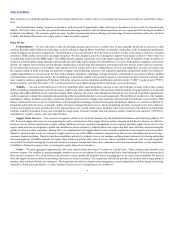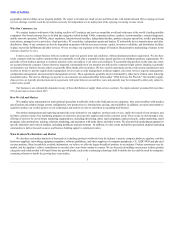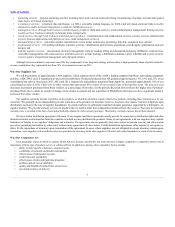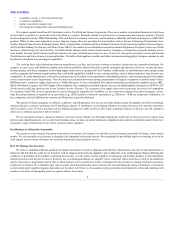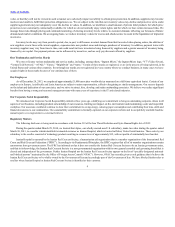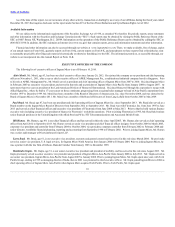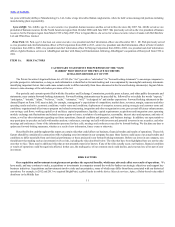Ingram Micro 2013 Annual Report Download - page 14
Download and view the complete annual report
Please find page 14 of the 2013 Ingram Micro annual report below. You can navigate through the pages in the report by either clicking on the pages listed below, or by using the keyword search tool below to find specific information within the annual report.
Table of Contents
to meet performance targets for the company may result in reduced levels of incentive compensation, which may affect our ability to retain key personnel.
Additionally, changes in our workforce, including those resulting from government regulations, collective bargaining agreements or the availability of qualified
personnel, could disrupt operations or increase our operating cost structure.
Our failure to adequately adapt to industry changes could negatively impact our future operating results. The technology and mobility
products industry is subject to rapid technological change, new and enhanced product specification requirements, evolving industry standards and changes in
the way technology products are distributed and/or managed. We have been and will continue to be dependent on innovations in hardware, software and
services offerings, as well as the acceptance of those innovations by customers. A decrease in the rate of innovation, or the lack of acceptance of innovations
by customers, could have an adverse effect on our business, results of operations or cash flows. Suppliers may also give us limited or no access to new
products being introduced.
Changes may cause inventory in stock to decline substantially in value or to become obsolete, regardless of the general economic environment. Although
it is the policy of many suppliers of products to offer distributors like us, who purchase directly from them, limited protection from the loss in value of
inventory due to technological change or such suppliers’ price reductions (“price protection”), if major suppliers decrease the availability of price protection to
us, such a change in policy could lower our gross margins on products we sell or cause us to record inventory write-downs. In addition, suppliers could
become insolvent and unable to fulfill their protection obligations to us. We offer no assurance that price protection will continue, that unforeseen new product
developments will not adversely affect us, or that we will successfully manage our existing and future inventories.
Significant changes in supplier terms, such as higher thresholds on sales volume before distributors may qualify for discounts and/or rebates, the
overall reduction in the amount of incentives available, reduction or termination of price protection, return levels, or other inventory management programs, or
reductions in payment terms or trade credit, or vendor-supported credit programs, may adversely impact our results of operations or financial condition.
Finally, if we were not able to adequately adapt to the emergence of alternative means of distribution for software and hardware, such as site licenses,
electronic distribution and cloud computing, our future operating results could be adversely affected.
We continually experience intense competition across all markets for our products and services. Our competitors include local, regional,
national, and international distributors, as well as suppliers that employ a direct-sales model. As a result of intense price competition in the IT and mobility
products and services distribution industry, our gross margins have historically been narrow and we expect them to continue to be narrow in the future. In
addition, when there is overcapacity in our industry, our competitors may reduce their prices in response to this overcapacity.
The competitive landscape has also experienced a consolidation among suppliers and customers and this trend is expected to continue, which could
result in a reduction or elimination of promotional activities by the remaining suppliers or customers as they seek to reduce their expenditures, which could, in
turn, result in decreased demand from end-users and our reseller customers for our products or services. Additionally, the past several years have witnessed a
consolidation within the mobile operator community, and this trend is expected to continue. This trend could result in a reduction or elimination of promotional
activities by the remaining mobile operators as they seek to reduce their expenditures, which could, in turn, result in decreased demand for our products or
services. Moreover, consolidation of mobile operators reduces the number of potential contracts available to us and other providers of logistic services. We
could also lose business or face price pressures if mobile operators that are our customers are acquired by other mobile operators that are our customers or not
our customers.
We offer no assurance that we will not lose market share, or that we will not be forced in the future to reduce our prices in response to the actions of our
competitors and thereby experience a reduction in our gross margins. Furthermore, to remain competitive we may be forced to offer more credit or extended
payment terms to our customers. This could increase our required capital, financing costs, and the amount of our bad debt expenses.
We have also initiated and expect to continue to initiate other business activities and may face competition from companies with more experience and/or
from new entrants in those markets. As we enter new areas of business or geographies, or we expand our offerings of new products or vendors, we may
encounter increased competition from current competitors and/or from new competitors, some of which may be our current customers or suppliers, which may
negatively impact our sales or profitability.
We have operations in 39 countries, spanning all global regions and sell our products and services to a global customer base of more than 200,000
customers in more than 170 countries. Based on currently available data, we believe that we are the market share leader in technology distribution, by net
sales, in North America and Latin America, and number two in Europe and Asia-Pacific. We are subject to competition law regulations in the markets which
we serve. Our market share may further adversely impact our ability to expand our business, as well as increase compliance requirements and costs
associated with such compliance.
14


